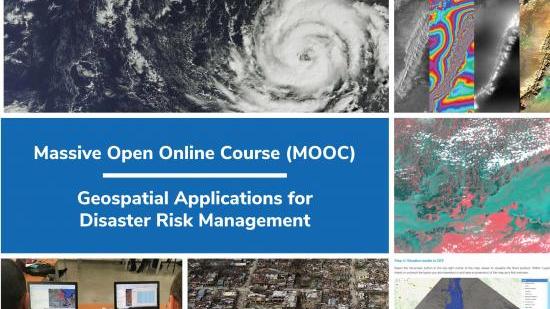Learning objectives
During the challenging times of the COVID-19 outbreak, MOOCs are an effective way of reaching a large number of participants to share knowledge. The United Nations Office for Outer Space Affairs and the Centre for Space Science and Technology Education for Asia and the Pacific (Affiliated to the United Nations) launched a Massive Open Online Course (MOOC) on “Geospatial Applications for Disaster Risk Management” on 13th October, 2020 the International Day for Disaster Risk Reduction.
The MOOC received an overwhelming response with registration from 29727 particpants from as many as 148 countries. It provided a free and flexible online training programme during pandemic time to everyone who wanted to enhance their capabilities related to the use of geospatial and Earth observation technologies in disaster risk management. Based on the feedback and request for continuation of MOOC a second phase of MOOC is planned to be launched, with additional lectures and hands on session.
The proposed Phase 2 of the MOOC registration will open on 01st June, 2021. The MOOC aims to strengthen efforts of disaster management professionals to contribute to achieving the targets of the Sendai Framework for Disaster Risk Reduction 2015-2030, the 2030 Agenda for Sustainable Development and the Paris Agreement stemming from the 21st Conference of the Parties (COP) of the United Nations Framework Convention on Climate Change (UNFCCC).
Target audience
Government officials and professionals, educators, university students and other stakeholders working in the field of disaster management
Tracks
The MOOC is structured in two tracks:
Track 1 (basic)
Who can attend: Professionals interested in enhancing awareness of the latest trends in disaster risk management and how geospatial and Earth observation technologies contribute to it
Progression: Candidates completing Track- can either leave the training programme or continue with Track-2
Certification: Candidates completing Track 1 will receive a certificate for completing the Basic Module
Track overview: Module 1: Overview of disaster risk management (DRM) and the relevance of geospatial technologies; Module 2: Earth observation and disaster management
Track 2 (advanced)
Who can attend: Professionals interested in sharpening skills in use of geospatial and Earth observation technologies in all phases of disaster management. Track 1 is a prerequisite for participating in Track 2
Progression: Track-2 can only be undertaken if Track-1 is completed
Certification: Candidates completing the basic and advanced module will receive a certificate for the entire MOOC
Track overview: Module 3: Earth Observation and geospatial intelligence for disaster management; Module 4: EO system and Hydrometeorological disasters; Module 5: EO system and geological disasters; Module 6: EO system and environmental disasters
Assessment
Each Module ends with a Self Assessment. The completion of the Self Assessment allows participants to access other modules
Language
All lectures and training materials will be in the English language
Registration
Registration Opens: 01-June-2021
Registration closes on 15-August-2021
MOOC closing
MOOC closes midnight of 31-August-2021
Duration
Track 1 and Track 2 training modules are of 12 hours duration each.
With a flexible schedule, the MOOC can be completed anytime during the duration the course remains open (from registration until close)
Cost
Free



